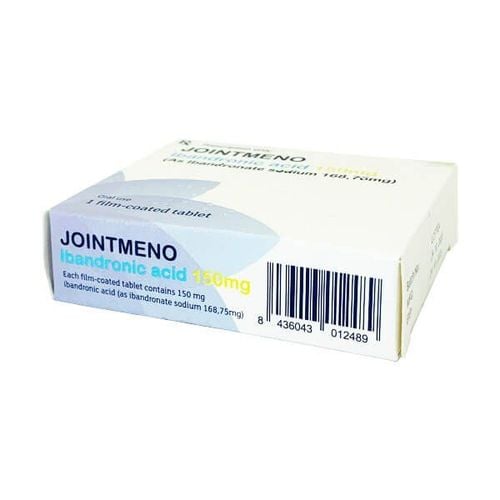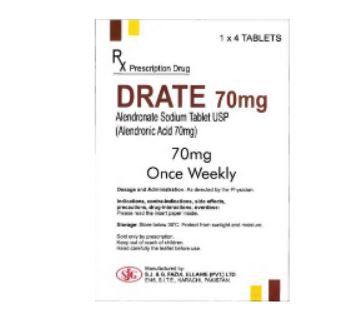This is an automatically translated article.
Osteoporosis and fracture risk in postmenopausal women is a normal physiological phenomenon. However, if left untreated, it can have serious consequences. Therefore, the use of osteoporosis drug Jointmeno is extremely necessary. So what is Jointmeno and how should it be used?
1. What is Jointmeno Osteoporosis?
Jointmeno is a product of Laboratorios Liconsa company (Spain), the main ingredient is ibandronic acid. Jointmeno is used for the prevention and treatment of osteoporosis in postmenopausal women at high risk of fracture.
Each tablet of jointmeno medicine 150mg Ibandronic acid
2. Indications of Osteoporosis Jointmen
Jointmeno is indicated in the following cases:
Prevention and treatment of osteoporosis in postmenopausal women at high risk of fracture; Reduces the risk of spinal fractures. Efficacy for femoral neck fractures has not been established. Ibandronic acid is a highly potent bisphosphonate active ingredient that has a selective effect on bone tissue, especially the ability to inhibit osteoclast activity without directly affecting bone formation. Jointmeno has not been shown to interfere with the recovery of osteoclasts. Mechanism of action, ibandronic acid helps bone achieve net mass growth and reduce fracture rates through its ability to reduce bone turnover that is elevated in postmenopausal women.

Thuốc jointmeno được sử dụng với mục đích dự phòng và điều trị loãng xương
3. Dosage and usage of Jointmeno
3.1. How to use Jointmeno Jointmeno is a drug used orally. When using jointmeno, patients need to take it in the morning after waking up (sleep must last at least 6 hours) and 1 hour before eating or taking any other medicine or supplements (including including calcium supplements).
Some notes on how to use jointmeno:
Take the whole pill with a full glass of water (about 180 - 240 ml) in a sitting or standing position, do not lie down within 1 hour after taking the medicine; Do not chew and suck on jointmeno tablets because of the risk of mouth and oropharyngeal ulcers; Only take jointmeno with filtered water, do not use mineral water with high calcium concentration. 3.2. Dosage of Jointmeno The recommended dose of jointmeno osteoporosis drug in normal people is 1 tablet of 150mg/month. Patients should choose a fixed day of the month to take the medicine.
During the use of jointmeno, patients should use calcium and/or vitamin D supplements if the diet does not provide enough of these two substances.
Dosage of jointmeno in some special cases:
People with renal impairment: No dose adjustment is required for mild and moderate renal impairment (creatinine clearance 30 ml/min or more). However, in cases of severe renal failure with creatinine clearance less than 30 ml/min, jointmeno should not be taken due to limited clinical data; People with liver failure, the elderly: No need to adjust the dose in this group of subjects; Children: Do not give jointmeno to children as the active ingredient ibandronic acid has not been studied in this age group. Some notes on the dosage of jointmeno osteoporosis drugs:
Optimal duration of osteoporosis treatment with bisphosphonates has not been published. There is therefore a need for periodic evaluation during treatment and consideration of whether to continue based on the potential benefits and risks in the individual patient, especially after 5 years of treatment or more; The dosage of the above jointmeno drug is for reference only, patients need to consult a doctor to get the most appropriate dose; There is no specific information on the treatment of overdose with ibandronic acid. However, based on available knowledge, an overdose of jointmeno may cause some side effects on the upper gastrointestinal tract (eg, epigastric pain, dyspepsia, esophageal or gastric ulcer) or lower blood calcium ; In case of forgetting to use jointmeno, the patient should take one pill the next morning as soon as he remembers (when the time for the next dose is more than 7 days). Then go back to the 1 pill/month cycle on the selected day. If the time to remember is 1-7 days until the next dose, the patient should wait for the next turn and take the medicine as usual; It is not recommended to take 2 jointmeno tablets in a period of 7 days.
4. Side effects of Osteoporosis Jointmeno
When using Jointmeno, patients may experience some unwanted side effects (ADR).
Of which some serious side effects can be experienced, including:
Allergic conditions such as rash, itching, swelling (face, lips, tongue and throat), difficulty breathing, anaphylaxis and possibly life-threatening life threatening; Severe chest pain, severe pain after eating, severe nausea, vomiting; flu-like symptoms such as fever, chills, shivering, fatigue, bone aches, muscle and joint pain; Pain or sores in the mouth/jaw; Eye pain and inflammation; Other possible side effects:
Headache; Muscle pain or stiffness, joint pain, back pain; Hypertension; heartburn, indigestion, nausea, stomach pain, gastroesophageal reflux disease, diarrhea or constipation; Asthma; Drowsiness, dizziness; Osteonecrosis of the jaw, Steven Johnson syndrome.

Jointmeno là một thuốc sử dụng qua đường uống
5. Some notes when taking Jointmeno
Some contraindications to the use of Jointmeno:
Narrowing or spasm of the esophagus because of the risk of delayed gastric emptying; The patient cannot stand or sit upright for at least 60 minutes after taking the drug; low blood calcium levels; Hypersensitivity or allergy to ibandronic acid and any of the ingredients in Jointmeno ; Severe renal impairment with creatinine clearance less than 30 ml/min; Some issues need to be cautious when using the osteoporosis drug Jointmeno:
Oral bisphosphonate has the potential to irritate the upper gastrointestinal mucosa and aggravate underlying medical conditions. Therefore, caution should be exercised when taking Jointmeno if there is an upper gastrointestinal problem such as Barrett's esophagus, difficulty swallowing, gastritis, inflammation or ulceration of the esophagus...; Adverse effects such as inflammation, ulceration and esophageal erosion of Jointmeno have been reported because of hospitalization. Rarely, bleeding or esophageal stricture/perforation may occur. The risk of serious esophageal side effects is increased when patients do not adhere to treatment and/or continue to take Jointmeno after symptoms of esophageal irritation; Hypocalcemia: Cases of confirmed hypocalcaemia need to be treated thoroughly before starting to use Jointmeno. Besides, some disorders of bone metabolism and other minerals should also be appropriately intervened, in which adequate calcium and vitamin D supplementation plays a relatively important role; Osteonecrosis of the jaw: Often associated with tooth extraction or local infection has been reported in cancers treated with intravenous bisphosphonates. In addition, osteonecrosis of the jaw has also been reported in some osteoporosis patients receiving oral bisphosphonates. Therefore, it is necessary to have dental examination and treatment before using Jointmeno in patients with risk factors for osteonecrosis of the jaw (such as cancer undergoing chemotherapy, radiation therapy, taking corticosteroids or the ability to clean teeth). poor mouth); Atypical Femoral Fractures: Transverse trochanter and long femoral fractures have been reported with bisphosphonates, mainly during the treatment of long-term osteoporosis. Consideration should be given to discontinuing Jointmeno therapy if an atypical femoral fracture is suspected. At the same time, during the course of treatment, the patient should inform the doctor if there is pain in the thighs, hips or groin and other unusual manifestations; Patients with galactose intolerance due to hereditary disorders, lactase deficiency or glucose or galactose malabsorption should not take Jointmeno. Some notes of Jointmeno drug on special subjects:
Jointmeno may cause headache, dizziness, drowsiness, pain or eye inflammation, so it should be used with caution when driving or operating machinery; Pregnancy: There are no data on the use of Jointmeno in pregnant women. Studies in rats have shown some reproductive toxicity of this drug and some unidentified potential hazards. Therefore, it is not recommended to use Osteoporosis Jointmeno for pregnant women; Lactation: It is not known whether ibandronic acid is excreted in human milk. Several studies in lactating rats showed the presence of low concentrations of ibandronic acid in milk following intravenous administration. Therefore, caution should be exercised when using this drug in this population.
6. Jointmeno drug interactions
Some drugs can interact with the osteoporosis drug Jointmeno , including:
Calcium, magnesium, iron and aluminum supplements because of the risk of affecting the effects of ibandronic acid; Aspirin or nonsteroidal anti-inflammatory drugs (including ibuprofen, diclofenac or naproxen) can cause gastrointestinal irritation similar to those of bisphosphonates. Therefore, caution should be exercised when non-steroidal anti-inflammatory drugs and Jointmeno are used concurrently; After taking Jointmeno, the patient should wait at least 1 hour before starting to use other drugs, including indigestion remedies, calcium supplements and vitamins; Do not take Jointmeno with food because it can reduce the effectiveness of the drug; Only take medicine with filtered water, do not use other types of water, including milk.
Please dial HOTLINE for more information or register for an appointment HERE. Download MyVinmec app to make appointments faster and to manage your bookings easily.













